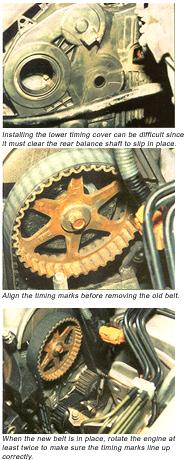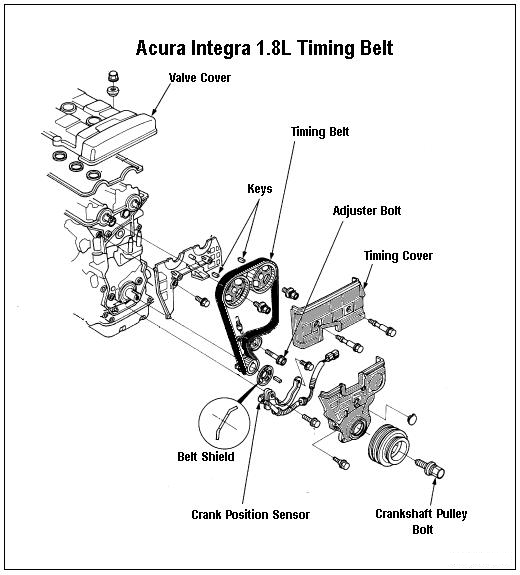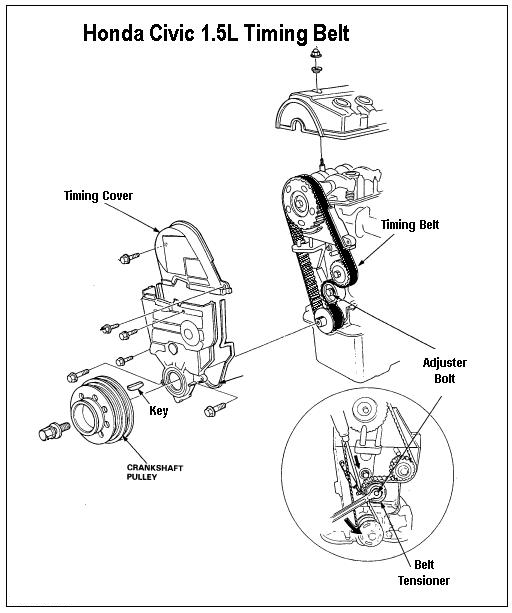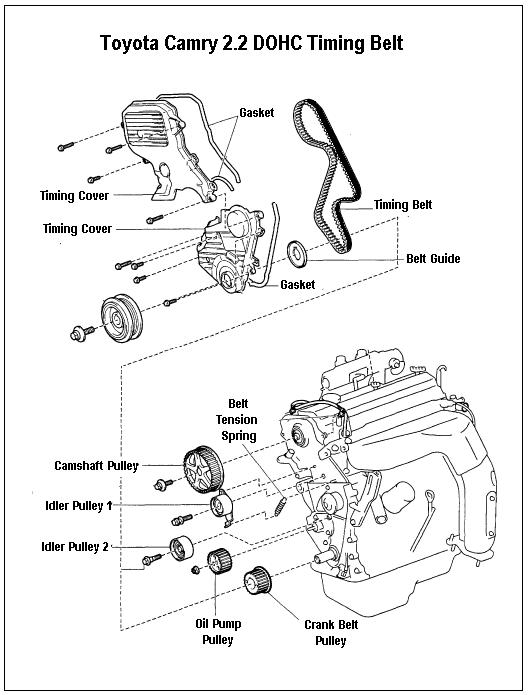Advertisement [ ? ]
Site Links
- Lease Calculator
- Advertise on 10,300+ pages
- My Car ongoing Review
- Members' Chat
- Cars For Sale
- Car Dealers
- Honda "Fit" Manual
- Hyperflex Bushings
- For Sale
- Fix your Car
- Car Manuals
- other manuals - Reference Materials
- DIY Repairs
- Articles
- Video
- Link with Us
- Search Help
- Code your Mac!
- Fly, race, anything R/C
- DIY repair guides
- Z-Seven
- Mechanic's Blog
- Free Files
Replacing Toyota and Honda Timing Belts and Chains
Whether you own a Honda or a Toyota, one thing all engines have in common is some type of cam drive system. With pushrod engines, a gear set or chain drive usually spins the cam. With overhead cam engines, it is a timing belt or chain.
As the miles add up, the cam drive wears the same as any other engine component. Gears develop play (backlash) between the teeth, chains stretch and belts weaken. Play in a gear or chain style cam drive can cause noise, retarded valve timing and/or ignition timing depending on the engine design and application.
With rubber timing belts, noise is seldom a problem even at high mileages. Valve timing and ignition timing (if it reads off the camshaft) also remain steady because timing belts do not stretch. But belts can and do fail - usually with little or no warning. The risk of belt failure goes up sharply once a belt surpasses its recommended replacement interval, which is typically 60,000 miles for belts in older vehicles (those built before 1990 to 1998), and 90,000 to 100,000 miles or more for newer vehicles.
Though todays timing belts last longer than ever before, the same cannot be said for timing belts in older engines - even if the vehicle manufacturer does not publish a recommended replacement interval. The fact is, any belt can fail if the reinforcing cords inside the belt become weak and break.
The internal cords prevent the belt from stretching and jumping time. The cords are under tremendous tension, and eventually the combination of constant flexing and heat causes them to weaken. If the belt is not replaced before total failure occurs, it will fail sooner or later. That is almost a certainty. It may go 60,000, 80,000, 100,000 or even 120,000 miles without a hitch. Or it may not even make it to 60,000 miles depending on operating conditions, load and rpm.
A visual inspection will not tell you much about a timing belt unless it is really bad. Belts that still look like new on the outside may be dangerously weak on the inside and on the verge of failure. That is why Honda, Toyota and most other vehicle manufacturers usually recommend replacing the timing belt at a specific mileage interval (see below).
Regardless of mileage, any timing belt that shows obvious damage such as frayed or exposed cords, damaged teeth, hunks of rubber missing, deep cracks, excessive surface cracking or severe glazing should be replaced without delay! Small surface cracks on the ribbing is considered normal. But extensive cracking or deep cracks are not.
Belt replacement is also recommended anytime the cylinder head has to come off of the engine, or when replacing a water pump that is driven off the timing belt. In both cases, the belt has to be removed anyway to make the other repairs so there is no extra labor required to replace it.

Waiting Can Be Very Costly
Many motorists will put off a timing belt replacement because it costs so much. The belt itself may not be that expensive, but the labor to change it is typically about four hours. It is also a very good idea to replace the water pump at the same time if the pump is mounted behind the belt. You do not want to do this job twice, and most water pumps have about the same lifespan as the belt. The total job can easily cost $500 to $600 or more depending on the vehicle. That is a lot of money to most people, but postponing the recommended maintenance can cost them a lot more!
On interference engines, a timing belt failure is really bad news because there is not enough clearance for the valves to clear the pistons if the belt snaps. A belt failure on an interference engine almost always results in one or more bent valves - or worse. That is why timing belts should be replaced at the recommended interval.
Regular belt replacement is especially important on Acura and Honda engines because almost every one of these engines is an interference design! The only exceptions are the 3.2L V6 in the 1998 and newer Acura SLX models, and the 3.2L V6 in 1994 and up Passports. With Toyota, there is less risk of additional engine damage because the only Toyota interference engines are the older 1.5L Tercel, 2.4L Pickup and 1.8L Camry and Corolla engines. Apparently, Toyota engineers were more generous with combustion chamber clearances than Honda engineers.
Convincing a customer to replace a timing belt that has not yet failed takes salesmanship - and education. Many motorists may not know timing belts have a limited lifespan and that the vehicle manufacturer lists a recommended replacement interval. But they do understand money. Explaining what it might cost to repair an interference engine with bent valves versus the cost to change the belt now might be all it takes to convince them of the value of preventive maintenance.
Replace The Timing Set
Most timing chain sets are sold as three-piece kits (chain, crank sprocket and cam sprocket), but some OHC kits also include a chain dampener or tensioner. These "extra" components play a vital role in supporting the chain and keeping it tight and should be replaced at the same time.
With OHC timing belts, do not replace the belt alone. Install a timing kit that also includes a new tensioner pulley. The cam and crank sprockets usually do not have to be replaced unless they show unusual wear or damage. Like the water pump, the service life of the tensioner pulley bearings is about the same as that of the belt.
Tensioner bearings are "sealed for life" and are not serviceable. So there is no way to clean, inspect or relubricate the bearings when a timing belt is changed. Over time, the grease inside breaks down and oxidizes, accelerating bearing wear and increasing the risk of a bearing failure or seizure. Also, the hotter the operating environment, the shorter the lifespan of the grease and the bearings. The location of the tensioner components under the timing belt cover prevents them from receiving much cooling, so they tend to run quite hot.
If a tensioner bearing seal fails, dirt and humidity can enter the bearing. At the same time, a leaky seal will allow the grease inside to escape, dooming the bearing to rapid failure.
On many newer engines, spring-loaded automatic tensioners are used to keep the timing belt tight. A slide plate allows the tensioner roller to move against the belt. As the miles accumulate, though, wear can cause the plate to stick against the engine block, preventing the tensioner from maintaining proper pressure. High underhood temperatures also can cause a loss of spring tension over time.
If the belt loses tension, it may jump time or slip. And if an idler pulley or tension seizes, it may cause the belt to suddenly snap.
It is difficult to determine the true condition of the tensioner components with a simple visual inspection because the components are not operating under a load. Even so, any pulley bearing that has visible looseness, grease streaks radiating outward from a damaged seal, makes noise or does not turn freely should be replaced before a new belt is installed - otherwise the new belt is doomed to premature failure.
Also, pay close attention to the front oil seals on the camshaft(s) and crankshaft. If they are leaking, now would be a good time to replace these parts, too.

Timing Belt R&R
Follow the recommended replacement procedure for the engine you are working on. Pay particular attention to the location of the timing marks in the manual and on the engine because some engines can be tricky to align. There may be multiple timing marks on the same sprocket. Unless you know which ones are correct to use, you may guess incorrectly.
On some Honda four-cylinders, you may find two different timing marks. A white mark may be used to indicate Top Dead Center (TDC) and a red mark for ignition timing. If you use the red mark instead of the white one, valve timing will be off as much as 18 degrees.
On older Honda 1.5L engines in the CRX, the cam sprocket says "UP" and there are three different timing marks. The sprocket should be aligned so UP is at the top, but the actual timing mark to use is the one at the 7 o'clock position that lines up with a plastic pointer on the head.
With early Honda single overhead cam engines, a camshaft that has been incorrectly timed and is overadvanced will have higher than normal idle vacuum and the engine will lack high speed power. You may also find some "false" diagnostic codes as a result of the mistimed cam.
In cases where the cam has been overadvanced, the engine computer will try to compensate by leaning out the air/fuel mixture. This, in turn, may make the mixture so lean that the O2 sensor ceases to switch, setting a code for a bad O2 sensor. There is nothing wrong with the O2 sensor, of course, because the real problem is the mistimed cam. The engine may also experience detonation (spark knock) because of the overadvanced valve timing and lean fuel mixture. This can be damaging to the head gasket, pistons and rings, and may cause the engine to run hot.
On Toyota 1.6L DOHC 4AF and 4AFE engines in Corolla and Celica models, timing the camshafts also can be confusing because the cam gears have two sets of timing marks. Each set of marks has a particular purpose. One set is used to time the intake with the exhaust camshaft when they are mounted in the cylinder head, and the other set indicates the TDC position for both camshafts.
General Tips
If you find a belt with stripped cogs, it indicates that something in the camdrive system has jammed or stuck, overloading the belt and causing it to shear teeth or jump time. The most likely culprit is the camshaft, which may have seized due to engine overheating or lack of lubrication (low oil level or loss of oil pressure). Check the coolant level, oil level and maintenance records of the vehicle. Toyota has been recommending 7,500-mile oil change intervals for some of its vehicles - which has lead to oil sludging and other engine problems. Changing the oil and filter every 3,000 miles or every three to six months is still the safest recommendation.
When OHC cylinder heads get too hot, they usually swell up in the middle, causing the cam to bend or bind. In some cases this may break the cam, snap the timing belt or shear the cam drive sprocket off the end of the cam.
Make sure the replacement belt is identical to the original. Belt length, width, tooth profile and pitch must be the same, and the material must be the same or better. Do not substitute a less expensive neoprene belt for one made of HSN. Use a quality brand of belt because some generic brands use inferior materials that will not last as long as the OEM belt or a quality aftermarket belt.

When changing a belt, never attempt to "stretch" a belt over a pulley. Belts, remember, do not stretch and forcing one to do so will likely damage the cords and cause it to fail.
Also, never pound on a sprocket to force it into place. If it is not sliding into place, check alignment and fit.
Misalignment problems in the cam drive also can occur if the cam sprocket is installed backwards, the wrong thickness of washer is used (incorrect end play), a thrust button is forgotten, or the crank sprocket is not positioned properly on its keyway.
Belt tension is critical to belt longevity. Adjust to the recommended specifications (always refer to the manual because the amount of recommended play can vary depending on the application). If the belt is too tight, it will not last. If the belt is too loose, it may jump time.
Finally, turn the engine over by hand several times to make sure the timing marks realign correctly. Then replace the covers and everything else that had to be removed to extract the belt.
Finish the job by installing a sticker indicating when the belt was changed (write down the mileage) and when the next change is due. Place the sticker where it can be easily seen on the timing cover or radiator shroud.
Factory Service Information Websites:
For detailed step-by-step timing belt replacement instructions, you can pay a subscription fee to access the factory service information via the OEM websites here:
Honda Service Information
Toyota Service Information
Aftermarket Service Information Website:
For less that what you would pay for a factory website subscription or a factory service manual, you can access the same timing belt replacement information from: ALLDATA
Belt Replacement Recommendations
The standard aftermarket recommendation for replacing OHC timing belts has traditionally been 60, 000 miles - which is still a valid number for most older vehicles. But newer belts last longer and may go 90,000 to 100,000 miles before the risk of failure starts to increase. With Acura and Honda, this means most 1990 and newer models. For Toyota, it is most 1998 and newer models.According to Gates Rubber Company's "Timing Belt Replacement Manual," these are the "official" belt replacement recommendations Acura, Honda and Toyota make for their specific engines.
Note: On applications where no specific mileage recommendation is given, it does not mean the timing belt will last indefinitely and can be ignored. It only means the vehicle manufacturer did not commit to a specific replacement interval and recommends the belt be replaced "as needed."
Also Note: On Acura and Honda applications with 105,000-mile recommended replacement intervals, this does not include vehicles that are operated in extreme climates (below -20 degrees F or above 110 degrees F). For extreme climate conditions, the replacement interval is reduced to 60,000 miles.
Honda also makes a time recommendation as well as mileage on the newer applications: 105,000 miles or 84 months, or 90,000 miles or 72 months depending on the engine.

Acura Timing Belt Replacement Mileage:
1998-97 Integra 1.8L
1998-97 NSX 3.0L & 3.2L
1998-97 2.5TL 5-cyl.
1998-97 3.0CL V6
1998-97 3.5RL V6
1998 SLX 3.5L
1998 2.3CL
1997-96 SLX 3.2L V6
1997 2.2CL
1996-95 2.5TL 5-cyl.
1996 3.2TL
1996-91 Integra 1.7L & 1.8L
1996-91 NSX 3.0L V6
1995-91 Legend 3.2L V6
1994-92 Vigor 2.5L 5-cyl.
1990 Integra 1.8L
1990 Legend 2.7L V6
1989-86 Integra 1.6L
1989-86 - Legend 2.5L & 2.7L

Honda Timing Belt Replacement Mileage:
1998-94 Passport 3.2L V6
1998 Accord 3.0L V6
1998 Accord & Odyssey 2.3L
1998 Civic 1.6L
1998 CRV 2.0L
1998 Prelude 2.2L
1997-95 Accord 2.7L V6
1997-95 Odyssey 2.2L
1997-92 Prelude 2.2L & 2.3L
1997-90 Accord 2.2L
1997-90 Civic 1.6L
1997 CRV 2.0L
1996-94 Passport 2.6L
1996-88 Civic Del Sol 1.6L
1995-90 Civic 1.5L
1991-90 CRX 1.5L
1991-90 Prelude 2.0L & 2.1L
1991-88 Civic & CRX 1.6L
1989-86 Accord & Prelude 2.0L
1989-84 CRX 1.3L & 1.5L
1987-79 Prelude 1.8L
1987-74 Civic 1.3L
1985-79 Accord 1.8L
1987-74 Civic 1.3L

Toyota Timing Belt Replacement Mileage:
1998 Avalon, Camry & Sienna 3.0L V6
1998 Camry & Celica 2.2L
1998 Land Cruiser 4.7L V8
1998 RAV4 2.0L
1998 Supra 3.0L
1998 Tacoma, T100 & 4Runner 3.4L V6
1998 Tercel 1.5L
1997-96 RAV4 2.0L
1997-96 4Runner 3.4L V6
1997-95 Avalon 3.0L V6
1997-95 Tacoma, T100 3.4L V6
1997-95 Tercel 1.5L
1997-94 Celica 1.8L
1997-93 Corolla 1.8L
1997-92 Camry 3.0L V6
1997-92 Paseo 1.5L
1997-90 Celica 2.2L
1997-88 Corolla 1.6L
1997-86 Supra 3.0L
1995-91 MR2 2.0L & 2.2L
1995-88 Pickup & 4Runner 3.0L V6
1994-93 Celica All-Trac 2.0L
1994-93 T100 3.0L V6
1994-88 Tercel 1.5L
1994-86 Celica 2.0L
1993-90 Celica 1.6L
1992-89 Cressida 3.0L
1991-88 Camry 2.5L V6
1991-83 Camry 2.0L
1989-85 MR2 1.6L
1988-83 Corolla 1.6L
1988-83 Cressida 2.8L
1987-84 Pickup 2.4L
1987-80 Tercel 1.5L
1986-83 Camry & Corolla 1.8L
Adapted from an article written by Larry Carley for Underhood Service magazine
Back to Engine Mechanical | Back to Info Main Page
Total messages: 0
